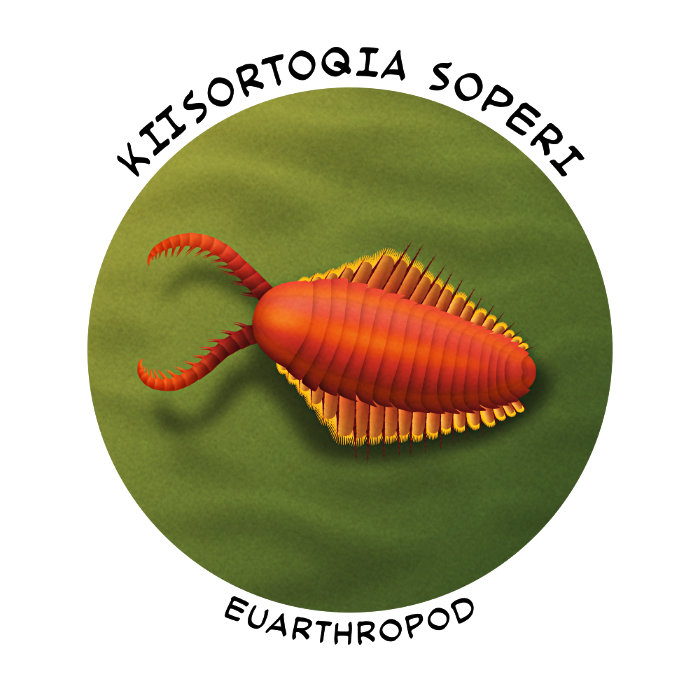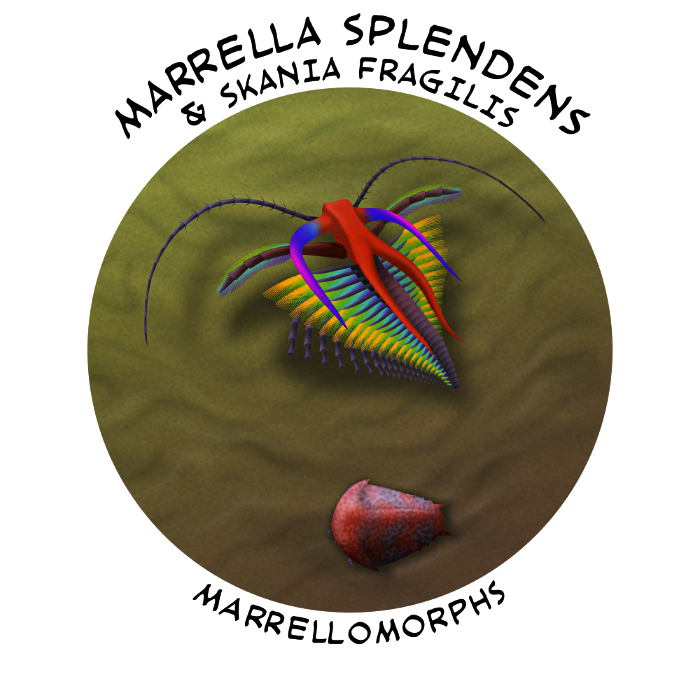The major groups of the euarthropods are the chelicerates, mandibulates, and the extinct artiopodans, but there were some Cambrian species that still can’t be easily fitted in to any of those lineages.

Kiisortoqia soperi is a fairly common species in the Sirius Passet fossil deposits in Greenland (~518 million years ago), with nearly 200 specimens discovered. About 5cm long (2″), its anatomy indicates it was definitely a euarthropod with a fully segmented arthrodized body and limbs – but it can’t be confidently associated with anything more specific than that.
It had a large pair of spiny grasping appendages on its head with a surprising resemblance those of radiodonts. It’s unclear if they were anatomically equivalent to those front appendages and inherited from an ancestral euarthropod with great appendages, or if they were convergently modified from antennae or another pair of limbs.
It’s been proposed as having some sort of relation with the panchelicerates, or with the artiopodans and trilobites. But it may also have just been sort of its own thing, part of a separate lineage of very basal euarthropods that were the “sisters” to all the rest of the group.
A very similar-looking species named Bushizheia was recently described from the similarly-aged Chinese Chengjiang fossil deposits, but sadly it doesn’t preserve any additional anatomical details that would actually help with figuring out these arthropods’ evolutionary affinities.
The marrellomorphs were a group of euarthropods that had unmineralized exoskeletons, making them unlikely to fossilize except in areas of exceptional preservation. They were striking-looking animals often sporting large elaborate head shields, and while only a few species are known due their very patchy fossil record, in some places they seem to have actually been incredibly common.
They were traditionally thought to be unusual trilobite-like animals and an early branch of the artiopodans or arachnomorphs, but some studies have instead recently placed then as stem-mandibulates. Their anatomy doesn’t fully match them to any of the major lineages, though, and it’s possible they were their own basal branch of weird euarthropods, very closely related to the ancestors of the other groups but not quite actually part of them.

The marrellomorph Marrella splendens, nicknamed the “lace crab”, is one of the most numerous fossils found in the Canadian Burgess Shale deposits (~508 million years ago), with over 25,000 specimens found.
About 2cm long (0.8″), it had large backwards-pointing spikes on its head, long antennae, a pair of stout paddle-like appendages, and around 25 body segments with biramous limbs. Preserved diffraction gratings on its outer spikes indicate parts of it were iridescent.
It may have used its paddle-like appendages for propulsion, swimming around in what must have been abundant colorful swarms in the then-tropical shallow Burgess sea. Its not clear if it had eyes – there may have been a pair located under the bases of the front spikes – but its later relative Mimetaster is at least known to have had small stalked eyes on its head.
Some of Marrella‘s rear legs had a mesh of spiny inwards projections on their undersides that might have functioned as a filter-feeding sieve, catching food particles and then later passing them up to its mouth using its other limbs.
Much much rarer in the Burgess ecosystem was Skania fragilis, known from less than 30 specimens.
It had a superficial resemblance to the enigmatic Ediacaran animal Parvancorina, and for a while the two were thought to potentially be closely related – but more recently Skania has been determined to have actually been another type of marrellomorph.
About 1cm long (0.4″), it was covered in a large carapace that gave it a trilobite-like shape, with the tips of a pair of antennae and several additional pairs of elongated antenna-like appendages sticking out at the front of its body, and many pairs of shorter legs hidden underneath.
Despite their incredibly patchy fossil record the marrellomorphs were a successful bunch for quite a while, and they lasted until at least the early Devonian (~400 million years ago). It’s likely they were wiped out later in that period by a series of extinction events that badly affected marine life at the time.
